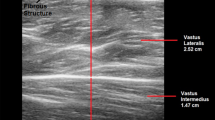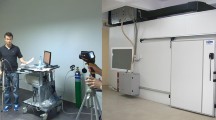Abstract
Purpose
The study aimed to compare thermal sensation in response to a fixed warm stimulus across 31 body locations in resting and active males and females.
Methods
Twelve males (20.6 ± 1.0 years, 78.1 ± 15.6 kg, 180 ± 8.9 cm, 34.4 ± 5.2 ml kg−1 min−1) and 12 females (20.6 ± 1.4 years, 62.9 ± 5.5 kg, 167 ± 5.7 cm, 36.5 ± 6.6 ml kg−1 min−1) rested in a thermoneutral (22.2 ± 2.2 °C, 35.1 ± 5.8 % RH) room whilst a thermal probe (25 cm2), set at 40 °C was applied in a balanced order to 31 locations across the body. Participants reported their thermal sensation 10 s after initial application. Following this, participants began cycling at 50 % \(\dot{V}{\text{O}}_{{ 2 {\text{max}}}}\) for 20 min, which was then lowered to 30 % \(\dot{V}{\text{O}}_{{ 2 {\text{max}}}}\) and the sensitivity test repeated.
Results
Females had significantly warmer magnitude sensations than males at all locations (4.7 ± 1.8 vs 3.6 ± 2.2, p < 0.05, respectively). Regional differences in thermal sensation were evident but were more prominent for females. Thermal sensation was greatest at the head then the torso and declined towards the extremities. In comparison to rest, exercise caused a significant reduction in thermal sensation for males (∆thermal sensation; 0.86 ± 0.3, p < 0.05), but only at select locations in females (0.31 ± 0.56, p > 0.05).
Conclusion
The data provide evidence that the thermal sensation response to warmth varies between genders and between body regions and reduces during exercise. These findings have important implications for clothing design and thermophysiological modelling.



Similar content being viewed by others
Abbreviations
- BSA:
-
Body surface area (m2)
- D b :
-
Total body density (g cc−1)
- EIA:
-
Exercise-induced analgesia
- T b :
-
Body temperature (°C)
- T c :
-
Core temperature (°C)
- TRPV:
-
Transient receptor potential vanilloid
- T sk :
-
Skin temperature (°C)
- %BF:
-
Body fat percentage (%)
References
American College of Sport Medicine (2005) ACSM’s guidelines for exercise testing and prescription, 7th edn. Lippincott Williams & Wilkins, Baltimore
Arens EA, Zhang K, Huizenga C (2005a) Partial- and whole body thermal sensations and comfort: part II: non-uniform environmental conditions. J Therm Biol 31:60–66. doi:10.1016/j.jtherbio.2005.11.02
Arens EA, Zhang K, Huizenga C (2005b) Partial and whole body thermal sensations and comfort; part I: uniform environmental conditions. J Therm Biol 31:53–59. doi:10.1016/j.jtherbio.2005.11.027
Beaumont A, Hughes J (1979) Biology of opioid peptides. Annu Rev Pharmacol 19:245–267
Cabanac M (1993) Selective brain-cooling in humans:” fancy” or fact? FASEB J 7:1143–1146
Casey KL, Morrow TJ (1984) Arousal-related changes in the response of VP thalamic neurons to somatic and spinothalamic stimulation in the awake monkey. Pain 18:S313
Claus D, Hilz MJ, Hummer L, Neundörfer B (1987) Methods of measurement of thermal thresholds. Acta Neurol Scand 76:288–296. doi:10.1111/j.1600-0404.1987.tb03583.x
Cotter JD, Taylor NA (2005) The distribution of cutaneous sudomotor and alliesthesial thermosensitivity in mildly heat-stressed humans: an open-loop approach. J Physiol 565:335–345. doi:10.1113/jphysiol.2004.081562
Cunningham DJ, Stolwijk J, Wenger C (1978) Comparative thermoregulatory responses of resting men and women. J Appl Physiol 45:908–915
Davies CTM (1979) Thermoregulation during exercise in relation to sex and age. Eur J Appl Physiol Occup Physiol 42:71–79. doi:10.1007/BF00421907
Fillingim RB, Maixner W, Kincaid S, Silva S (1998) Sex differences in temporal summation but not sensory-discriminative processing of thermal pain. Pain 75:121–127. doi:10.1016/S0304-3959(97)00214-5
Fournet D, Ross L, Voelcker T, Redortier B, Havenith G (2013) Body mapping of thermoregulatory and perceptual responses of males and females running in the cold. J Therm Biol 38:339–344. doi:10.1016/j.jtherbio.2013.04.005
Fowler CJ, Carroll M, Burns D, Howe N, Robinson K (1987) A portable system for measuring cutaneous thresholds for warming and cooling. J Neurol Neurosurg Psychiatry 50:1211–1215. doi:10.1136/jnnp.50.9.1211
Franklin BA, Whaley MH, Howley ET, Balady GJ (2000) ACSM’s guidelines for exercise testing and prescription: testing and prescription lippincott. Williams and Wilkins, Baltimore
Golja P, Tipton MJ, Mekjavic IB (2003) Cutaneous thermal thresholds—the reproducibility of their measurements and the effect of gender. J Therm Biol 28:341–346
Guieu R, Blin O, Pouget J, Serratrice G (1992) Nociceptive threshold and physical activity. Can J Neurol Sci 19:69–71. doi:10.1016/S0306-4565(03)00010-X
Hardy JD, Dubois EF (1938) Basal metabolism, radiation, convection and evaporation at temperatures from 22 to 35°C. J Nutr 15:477–492
Havenith G (1997) Individual heat stress response. Thesis, Nijmegen University, Ponsen and Looijen press, Wageningen, 1997. ISBN 90-9010979. http://dare.ubn.kun.nl/bitstream/2066/18586/1/18586_indihestr.pdf
Havenith G (2001a). An individual model of human thermoregulation for the simulation of heat stress response. J Appl Physiol 90: 1943–1954. Retrieved from http://www.jappl.org/content/90/5/1943.full.pdf+html
Havenith G (2001b) Human surface to mass ratio and body core temperature in exercise heat stress- a concept revisited. J Therm Biol 26:387–393. doi:10.1016/S0306-4565(01)00049-3
Havenith G, Fogarty A, Bartlett R, Smith C, Ventenat V (2008) Male and female upper body sweat distribution during running measured with technical absorbents. Euro J Appl Physiol 104:245–255. doi:10.1007/s00421-007-0636-z
Hensel H (1973) Neural processes in thermoregulation. Physiol Rev 53:948–1017
Heyward VH, Wagner VR (2004) Body composition assessment. Human Kinetics, Champaign
Inoue Y, Tanaka Y, Omori K, Kuwahara T, Ogura Y, Ueda H (2005) Sex-and menstrual cycle-related differences in sweating and cutaneous blood flow in response to passive heat exposure. Euro J Appl Physiol 94:323–332. doi:10.1007/s00421-004-1303-2
Jackson AS, Pollock ML (1978) Generalized equations for predicting body density of men. Br J Nutr 40:497–504
Jackson AS, Pollock ML, Ward A (1980) Generalized equations for predicting body density of women. Med Sci Sports 12:175–182
Janal MN, Colt EWD, Clark WC, Glusman M (1984) Pain sensitivity, mood and plasma endocrine levels in man following long-distance running: effects of naloxone. Pain 19:13–25. doi:10.1016/0304-3959(84)90061-7
Jasper H, Penfield W (1954) Epilepsy and the functional anatomy of the human brain, 2nd edn. Little Brown and Co, Boston
Kemppainen P, Pertovaara A, Huopaniemi T, Johansson G, Karonen SL (1985) Modification of dental pain and cutaneous thermal sensitivity by physical exercise in man. Brain Res 360:33–40. doi:10.1016/0006-8993(85)91217-X
Kemppainen P, Pertovaara A, Huopaniemi T, Johansson G (1986) Elevation of dental pain threshold induced in man by physical exercise is not reversed by cyproheptadine-mediated suppression of growth hormone release. Neurosci Lett 70:388–392. doi:10.1016/0304-3940(86)90585-9
Kenshalo DR Sr (1986) Somesthetic sensitivity in young and elderly humans. J Gerontol 41:732–742
Koltyn KF (2000) Analgesia following exercise: a review. Sports Med 29:85–98. doi:10.2165/00007256-200029020-00002
Lautenbacher S, Strian F (1991) Sex differences in pain and thermal sensitivity: the role of body size. Atten Percept Psychophys 50:179–183. doi:10.3758/BF03212218
Lee U, Tamura T (1995) Distribution of cold sensitivity over human skin. Jpn Soc Home Econ 46:1081
Meh D, Deništič M (1994) Quantitative assessment of thermal and pain sensitivity. J Neurol Sci 127:164–169. doi:10.1016/0022-510X(94)90069-8
Nadel ER, Mitchell JW, Stolwijk JAJ (1973) Differential thermal sensitivity in the human skin. Pflüg Arch Euro J Physiol 340:71–76
Nagasaka T, Brinnel H, Hales J, Ogawa T (1998) Selective brain cooling in hyperthermia: the mechanisms and medical implications. Med Hypotheses 50:203–211. doi:10.1016/S0306-9877(98)90019-6
Nakamura M, Yoda T, Crawshaw LI, Yasuhara S, Saito Y, Kasuga M, Nagashima K, Kanosue K (2008) Regional differences in temperature sensation and thermal comfort in humans. J Appl Physiol 105:1897–1906. doi:10.1152/japplphysiol.90466.2008
Otto MW, Dougher MJ (1985) Sex differences and personality factors in responsivity to pain. Percept motor skills 61: 383–390. Retrieved from http://www.amsciepub.com/doi/pdf/10.2466/pms.1985.61.2.383
Ouzzahra Y, Havenith G, Redortier B (2012) Regional distribution of thermal sensitivity to cold at rest and during mild exercise in males. J Therm Biol 37:517–523. doi:10.1016/j.jtherbio.2012.06.003
Paalasmaa P, Kemppainen P, Pertovaara A (1991) Modulation of skin sensitivity by dynamic and isometric exercise in man. Eur J Appl Physiol Occup Physiol 62:279–285. doi:10.1007/BF00571553
Parsons KC (2003) Man and his thermal environment: the effects of hot, moderate, and cold environments on human health, comfort, and performance, 2nd edn. Taylor & Francis, London
Paulson PE, Minoshima S, Morrow TJ, Casey KL (1998) Gender differences in pain perception and patterns of cerebral activation during noxious heat stimulation in humans. Pain 76:223–229. doi:10.1016/S0304-3959(98)00048-7
Pertovaara A, Huopaniemi T, Virtanen A, Johansson G (1984) The influence of exercise on dental pain thresholds and the release of stress hormones. Physiol Behav 33:923–926. doi:10.1016/0031-9384(84)90230-0
Ramanathan NL (1964) A new weighting system for mean surface temperature of the human body. J Appl Physiol 19:531
Sinning WE, Wilson JR (1984) Validity of “generalized” equations for body composition analysis in women athletes. Res Q Exerc Sport 55:153–160. doi:10.1080/02701367.1984.10608392
Sinning WE, Dolny DG, Little KD, Cunningham LN, Racaniello A, Siconolfi SF, Sholes JL (1985) Validity of “generalized” equations for body composition analysis in male athletes. Med Sci Sports 17:124–130. Retrieved from http://www.setantacollege.com/wp-content/uploads/Journal_db/Validity%20of%20composition.pdf
Smith CJ, Havenith G (2011) Body mapping of sweating patterns in male athletes in mild exercise-induced hyperthermia. Eur J Appl Physiol 111:1391–1404. doi:10.1007/s00421-010-1744-8
Smith CJ, Havenith G (2012). Body mapping of sweating patterns in athletes: A sex comparison. Med Sci Sports, Online First 2012; doi: 10.1249/MSS.0b013e318267b0c4
Stevens JC, Marks LE, Simonson DC (1974) Regional sensitivity and spatial summation in the warmth sense. Physiol Behav 13:825–836. doi:10.1016/0031-9384(74)90269-8
Velle W (1987) Sex differences in sensory functions. Perspect Biol Med 30:490–522
Acknowledgments
The authors would like to acknowledge the continued support from Oxylane Research during this study, in particular Dr. Sophie Herpin.
Conflict of interest
The present research was done in the context of an industry—co-funded PhD by Oxylane Research (Decathlon R&D Department) and the Loughborough Design School (Environmental Ergonomics Research Centre). Bernard Redortier and Thomas Voelcker, members of the sponsoring industry (Oxylane Research), contributed to the conception and design of the experiment and contributed to the paper write-up. Nicola Gerrett and George Havenith were fully responsible for conducting the trials and the data analysis. The authors declare that they have no conflict of interest.
Author information
Authors and Affiliations
Corresponding author
Additional information
Communicated by Narihiko Kondo.
Rights and permissions
About this article
Cite this article
Gerrett, N., Ouzzahra, Y., Coleby, S. et al. Thermal sensitivity to warmth during rest and exercise: a sex comparison. Eur J Appl Physiol 114, 1451–1462 (2014). https://doi.org/10.1007/s00421-014-2875-0
Received:
Accepted:
Published:
Issue Date:
DOI: https://doi.org/10.1007/s00421-014-2875-0




